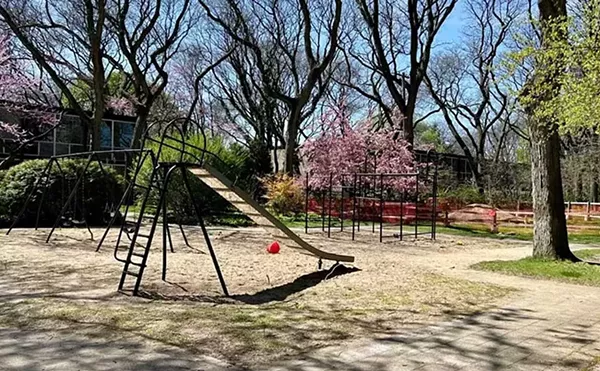
Audio By Carbonatix
[
{
"name": "GPT - Leaderboard - Inline - Content",
"component": "35519556",
"insertPoint": "5th",
"startingPoint": "3",
"requiredCountToDisplay": "3",
"maxInsertions": 100,
"adList": [
{
"adPreset": "LeaderboardInline"
}
]
}
]
An androgynous-looking girl is standing in an austere modern house, the walls of which are made completely out of glass. We can see her through the glass standing at a digital keyboard, with earphones on, making and listening to music. A window washer is cleaning the outside of the windows, figuratively caressing them, while she is completely oblivious to him. This completely compelling voyeuristic moment is a video installation called “Le Baiser/The Kiss.” That’s all there is to it, except for the minimalist music of the sound track that includes the sound of the wind and the window washer’s squeegee making kissing noises on the glass. The piece got its name from the sound track by composer Jeremy Boyle, who took one note of a KISS guitar solo and digitally repeated it for the full video.
This is a bare-bones description of “Le Baiser/The Kiss,” one part of a trilogy of gorgeously challenging video works by Iñigo Manglano-Ovalle, a Chicago artist on view through Nov. 25 at the Cranbrook Art Museum (39221 Woodward Ave., Bloomfield Hills — call 248-645-3323). Coincidentally, last week Manglano-Ovalle was awarded the prestigious MacArthur Fellowship which is often referred to as the “genius grant.” The fellowship is a lifetime-achievement award that recognizes a major contribution to the arts, yet the artist is only 40 years old.
What’s extraordinary is that Manglano-Ovalle has a reputation for engaging culture on a social-activist level, while working with, if not directly challenging, issues and materials of science and technology (until recently a combination not seen much). In one project (called “Street-Level Video”), he taught 50 mostly Latino teenagers from the barrio in Chicago’s West Town how to use video equipment. They “shot” their lives with the camera (a process called “identity mapping”) and then for one amazing, celebratory night lit up a block of the barrio with 75 monitors — placed on milk cartons in empty lots and on apartment stoops — that imaged, as well as transmitted on closed circuits, their lives to themselves and the community. For one night, the West Town community was hardwired by television cable and could look at and celebrate who they are with a new level of consciousness.
The simple scenario of “Le Baiser/The Kiss,” on the other hand, uses famed High Modernist architect Mies van der Rohe’s Farnsworth House, a model of the use of technology in architectural design, as a site for an encounter between worker (the window washer played by the artist himself) and owner (DJ girl). The video is projected on a transparent screen suspended from the ceiling with an aluminum framework that looks like an extension of the house itself. The audience is able to walk in and around the projection space and experience the bizarre, though routine, abyss between the figures. The transparency of the house literally illuminates the social divide that modernist culture in all of its high-tech efficiency fails to recognize — inside/outside, male/female, worker/boss, nature/manmade, silence/language — and even makes worse.
If “Le Baiser/The Kiss” explores modernist culture on the level of social identity, the other two parts of the trilogy make an exponential leap into global and even universal culture. “Climate” is a piercingly beautiful video shot on location in Mies’ Lake Shore apartments in Chicago high above Lake Michigan.
And “Alltagszeit (In Ordinary Time),” situated in the great entrance hall of Mies’ Berlin art museum (Neue Nationalgalerie), pushes even further into the subject of human alienation.
The Hot & the Bothered was written by Glen Mannisto and edited by George Tysh. E-mail at gtysh@metrotimes.com




